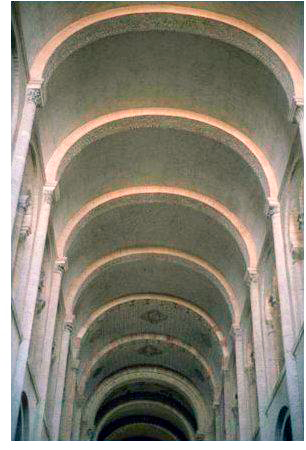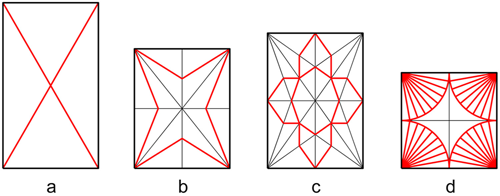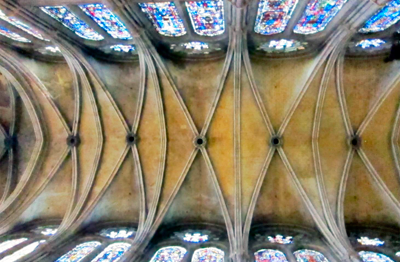GLOSSARY
|
This glossary is designed to explain or
clarify some of the terms used in the text; these terms refer to the
church, clergy, architecture and aspects of the monuments. This glossary
is on-going and will be added to or revised at intervals. I would
welcome any modifications or clarifications that visitors to the site
may think useful. If any point is at all unclear, please let me know.
Essentially the section of the clergy applies to the people you might
meet and certainly of those you will see church monuments to in churches
you will visit.
One thing I have discovered in writing this glossary: I would not like
to compile a dictionary!
|
|
|
| Please note that this glossary is
being gradually compiled so is far from complete. There will be words in
the explanation which themselves need explaining, rather like trying to
follow computer instructions. I will add these further explanations in
due course. I expect there are many typos too but these too will be
rectified in due course. I find proof reading difficult but find that
uploading a page and reading it on line helps considerably but this also
means that uncorrected work appears for a time on line. |
| |
|
| Advowson |
The right of nomination or presentation to a
benefice. An advowson is held by a patron, who may a
clerical or secular individual or an institution. The patron presents the
candidate for the benefice to the bishop for institution and
induction, although this nomination may actually be refused. An
advowson is regarded as a from of property and, as such, may be disposed
of in several ways and is subject to civil law. |
| Appropiate (verb) |
To take something without the owners permission. To
commandeer. In fact, to steal.
Note: In the present glossary appropriation refers to the
annexation of the parish tithes and other endowments to a
religions house; that institution then becomes effectively the
rector, who receives the great tithes, and appoints a vicar
to care for the parish, who receives the lesser tithes.
Impropriation refers to the annexation of an ecclesiastical
benefice to a lay proprietor or institution. At the dissolution of the
monasteries many benefices which had been appropriated to monasteries
passed to lay rectors, who were obliged to appoint perpetual curates to
care for the parish. The word appears to means to grant. |
| Benefice (Latin: beneficium) |
The word 'benefice' is derived from the Latin
'beneficium' - a 'benefit' - and, under the Roman Empire,
was a reward granted to the individual for services rendered to the
state; the word and its meaning was eventually adopted by the church. In
the Church of England it is the granting of an office and rights and
assets that accompany it - such as land in the parish - for rendering
the services that accompany it, such as the spiritual welfare of the
parishioners. There are three kinds of benefices: rectories, vicarages, and,
until 1968 perpetual
curacies. A benefice is also known as a 'living'.
A cleric may not be deprived of his or her benefice unless he or she is
guilty of some misdemeanor under ecclesiastical law. |
| Collegiate Church |
A church served by a chapter of canons and/or
prebendaries but is not a cathedral. Westminster Abbey
is a collegiate church; it was actually once an abbey and then a
cathedral for a short period. There were once many more. |
| |
|
| Cathedral |
A church which contains cathedra or throne
of the bishop of the diocese. The head church of the
diocese. |
| Cathedrals of the Modern Foundation |
In the nineteenth century with the increase of
population in the industrial centres, especially in the north, many of
the old dioceses had become too large to manage so twenty new cathedrals
were created. Some of these were former monastic churches, others were
parish churches, while three new cathedrals were built. At Coventry a
fourth new cathedral replaced, yet integrated with, the bombed out
parish church. These new creations are termed Cathedrals of the
Modern Foundation. |
| Cathedral of the New Foundation |
At the time of the Reformation eight Cathedrals were
served by monks under a prior or - in the case of
Carlisle by canons regular. These were known as cathedral
priories. These were reorganized on secular grounds to be served by
secular canons under a dean. At the same time five former
monastic churches were elevated to cathedral status. Actually the latter
number was really six, as Westminster Abbey served as a cathedral for ten
years. These were all termed Cathedrals of the New Foundation. |
| Cathedral of the Old Foundation |
At the time of the Reformation nine Cathedral were
served by secular canons under a dean; their administration was left
virtually unchanged. They are referred to as Cathedrals of the Old
Foundation
Note: The terms Old Foundation and New Foundation
can be confusing and even somewhat ambiguous. Cathedrals of the Old
Foundation existed before the reformation, and were already organized in
the 'revised' or 'new' way; that is, they did not require refounding.
Cathedrals of the New Foundation actually refers to two quite separate
entities: firstly athedrals that did exist before the
Reformation but were organized in a monastic fashion and were refounded
as 'secular' cathedrals; and, secondly, newly created cathedrals that
did not exist (as cathedrals) as such before the Reformation, but had
been monastic or parish churches which were then raised to the rank of
cathedral. |
| Cathedral Priory |
In the case of a cathedral of the old foundation,
the bishop of the diocese was also the titular abbot of the
monastery, although the day to day running devolved on the prior,
the abbot's deputy. Hence the term 'cathedral priory'. |
| Cenotaph |
From two Greek words meaning empty tomb. It
refers to a monument to a person or a group of persons who are buried
elsewhere or whose remains have never been discovered, as well as
sometimes an
initial tomb for a person who later would be reburied elsewhere. War memorials are often
referred to as cenotaphs and The Cenotaph refers to
the monument in Whitehall to the victims of both world wars. This is a rather wide
definition and could refer to wall monuments or tablets although these
are never referred to as cenotaphs.
I will use the more restricted meaning of the term in these pages. For
example, General Redvers Buller VC is actually buried in the churchyard
of the parish church of Credition, Devon and also has an interesting
wall monument in the church itself. He is also commemorated by a wall
monument of the more usual design in Exeter Cathedral as well as an
equestrian statue in the city outside Exeter college. There is an actual
cenotaph in the strictest sense in Winchester Cathedral; this is a tomb
with tomb chest and a recumbent effigy. |
| Chancel Screen |
A carved stone, wood, or metal screen separating the
chancel from the nave. If it has a rood, it
is then termed a rood screen; many former Rood Sreens have
survives as chancel screen, the Roods having been removed. In
the middle ages the nave of the church was often used for secular
purposes, being the only suitable meeting place in the village, and this
acreen acted to preserve the sanctity of the chancel |
| Chapel of Ease |
A chapel which was established in a large parish and
which was subordinate to the parish church. The purpose was to make it
easier for parishioners if they lived a long distance from the
parish church to attend services. They are normally served by clergy of
the parish but do not have their priest-in-charge.
Chapels of Ease still exist but many have became parish churches in
their own right.
|
| |
|
The
Chapter |
The clerical body who governs a cathedral church; also a clerical body who governs a rural deanery.
Here we will discuss the Cathedral Chapter.
Cathedral governance is quite complicated and the reader is unlikely to
encounter is: but read on if you find such things interesting or
intriguing. The chapter is the body responsible
for the cathedral's admonition and the Dean is the
chairperson of the chapter. The Chapter consists of the Dean and all the
Residentiary Canons, together with two to seven other persons, two thirds
of whom are lay persons, together with the Chapter Clerk, the cathedral
administrator.
Another body is the Council, a supervisory body to
which the Chapter is accountable. Its duty is to further and support the
work of the cathedral and review and advise on that work. It receives
and considers the annual budget, accounts and reports as well as making
changes to the constitution , subject to the consent of the bishop. The
council consists of a lay chairperson appointed by the bishop),
he dean, between two and five members of the chapter (chosen by it), two
members of the College of Canons (see below)
appointed by it, and between two and four persons representing the
cathedral community, and finally, between five and ten persons having
experience of cathedral or wider interest.
The College of Canons is involved in the formal
election of the Diocesan bishop and receives the cathedral's annual
report and accounts. The College of Canons consists of the Dean, all
residentiary, non-residentiary and lay canons, and all suffragan and
fully time stipendary assistant bishops and archdeacons.
|
| Clergy |
This section will mostly be in alphabetical order.
|
The term clergyman, clergy or cleric comes from the Latin clericus
meaning a priest; from the same word we derive the word
clerk and from time to time we see on a monument words such
as John Smith MA clerk, Vicar of this parish for 50 years.
We now think of a clerk as someone who files, answers the
telephone, keeps records etc. However the word is also used in
terms such a magistrate's clerk who is legally
qualified and advises the lay
magistrates on points of law, among other duties. This came
about as follows. In early centuries, in the main, only priests
could read and write and a large house would employ a priest to
read, write, keep records as well as conducting religious
services. Early important civil servants, such as the chancellor, would be
bishops, often combining this work (and income) with their
religious duties. What was the point of learning to read and
write: the wealthy employed clerks and the peasants had no need
to, after all there were no printed books, newspapers or any
other printed matter. The printing press with moveable type
yet to be invented.
When more people learned to read and write clerk began to
mean what it day today so a priest became known as a clerk
in holy orders, not a term much in use today.
I will use the term cleric for the
official term clerk in holy orders in this discussion,
a unisex terms which avoids the cumbersome terms clergyman or clergywoman.
|
|
ORDERS
|
Like the
military there are 'ranks' in the clergy, called orders,
but unlike the complicated military ranks (sergeant, captain,
colonel etc) there are only three orders: deacon, priest, and
bishop. In earlier times there were more but now, although
initially it may appear that there are more, what may seem like
an order is in fact a post or job. This is similar to the
military which have posts: for example Warrant Officer is a
rank, but Sergeant-Major is an appointment held by warrant
officer. In the church there are several appointments, canons,
archdeacons, deans, vicars etc.
To add confusion, a bishop is both an appointment and an order. In
contrast an archbishop is an appointment: his or her order is a
bishop. Titles
present a complicated and fascinating study in themselves but I
will deal only with the church here; the military is a study in
itself for browsing through Google. |
| |
| Deacon - (Greek: servant)
A cleric is first ordained deacon by the bishop. A deacon is
licensed to preach, undertake pastoral duties, baptize and
officiate a funerals but cannot celebrate Holy Communion or
solemnize a marriage, among other items. A cleric normally
remains a deacon for a year and is then ordained priest |
| Priest - (Latin:
elder) A priest can carry out all the duties
of a deacon but in addition may, in addition, celebrate the
Eucharist, solemnize a marriage, give absolution and give a
blessing. A person cannot be ordained priest before the age of
24, nor be concentrated bishop before the age of 30. |
|
Bishop - (Greek - overseer) A bishop
can carry out all the duties of a priest but, in addition, can
confirm and ordain. |
| |
| |
POSTS
| Abbot (Latin:
father) (priest) |
The head of a major religious house of the
Benedictine Order or certain orders of Canons Regular.
Normally elected for life by the monks. The abbot (or
abbess, if a community of nuns) is entrusted with
the government of the abbey and independent of the
authority of the bishop |
| Archbishop (bishop) |
An archbishop is a bishop who is in
charge of a province. In England there are two
archbishops: Canterbury and York. Each province contains
a number of dioceses.
Title: The Most Reverend and Right Honorable.
Form of Address: Your Grace. |
| Archdeacon (priest) |
A cleric who has administrated
authority over an Archdeaconry (q.v.) An
archdeacon has disciplinary supervision over the clergy
and for the proper administratioof church property as
well as other responsibilities. A cleric must be in Holy
Orders to become an archdeacon
Title: The Venerable __ . n Form of address:
Archdeacon __ |
| Archpriest (priest) |
The title archpriest was,
in the middle ages, the priest of the principal parish
among several local parishes. The archpriest had a
supervisory role - but not jurisdiction - over these
other parishes. The title fell into disuse but it was
confirmed as late as 1913 in Council by King George V.
The role was similar to that of a modern day Rural
or Area Dean (q.v.) There are two archpriests
in England: at Haccombe and Bere Ferris, both in Devon.
An archpriest, in theory, in not subject to the
authority of the local bishop, but directly to that of
the Archbishop of Canterbury. He or she bears no special
title nor form of address and the title archpriest
remains with the parish and does not stay with the
priest should he or she transfer to another parish. |
| Assistant
Bishop (bishop) |
See below, Bishop |
| Bishop (bishop) |
A Diocesan Bishop (Greek: overseer)
in charge of a Diocese or See and is usually known as
The Bishop of (name of diocese). A Suffragan Bishop (Latin:
support by vote) is usually a bishop who assists the diocesan
bishop on the latter's behalf and with his authority. Also known as an
Area Bishop and is usually known as The Bishop of (major town
in the diocese). An Assistant Bishop assists the
diocesan bishop in a similar fashion but unlike a suffragan bishop has
no security of tenure.
Title: The Right Reverend the Lord Bishop
Form of Address: My Lord or Bishop
|
| Canon (priest) |
One of the permanent salaried
staff of a cathedral; a member the chapter of a
cathedral. More properly a Residentiary Canon.
A Honorary Canon is a member of the cathedral
chapter but does not hold a salaried post. A honorary
canon may be a cleric or lay person; they are given the
post as a reward fpr oustanding service to the
church. Both
residential and honorary canons can vote for or
reject the Crown's nomination of a bishop to a vacant
see.
A minor canon is a cleric who is usually chosen for
their ability to sing in the cathedral services but have
no part in cathedral government. Only cathedrals of the
new foundation - with the exception of St Paul's, London
- have minor canons.
Title: The Reverend Canon __ . Form of address:
Canon __ |
| Canon Regular |
Member of a community of canons living under a
rule, usually that of St Augustine, as would a monk but a canon
regular is necessarily ordained. |
| Chancellor (priest) |
In England the cathedral chancellor
is one of the four principal officers of the nine
cathedrals of the old foundation. The chancellor
is responsible to the Dean and
Chapter for the cathedral library and associated with
the government of the cathedral school and other
educational functions.
The Cathedral Chancellor is not to be confused with
the Diocesan Chancellor. |
| Chaplain (priest) |
Originally a cleric who was in
charge of a chapel. It now refers to a cleric who
performs specialized duties outside the parish; for
example to a hospital, to the Forces, to a school, to a
prison, to a university and other bodies. |
|
Curate (one having charge) (deacon or priest) |
Originally a cleric who had the cure
(care) of souls in the parish; it now means a cleric who
assists the parish priest in the performance of his or
her duties. |
Dean (Latin: Ten)
(priest) |
The word was originally applied to
an official supervising ten novices. Here we will refer
to a Cathedral Dean; he or she is the
head of the cathedral chapter and as
such has the duty of governing and regulating the life
and work of the cathedral on the chapter's behalf.
In the cathedral hierarchy the Dean ranks after the
Bishop of the Diocese. The Dean's powers and duties
depend on the individual cathedral's constitution and
statutes, but the Dean has important functions with
regard to various aspects of the day to day life of the
cathedral; he or she also considerable independence.
You may remember the BBC comedy All
Gas and Gaiters which
showed disputes between the Bishop (played by William
Mervyn) and the Dean (played by John Barron). However
such disputes, believe it or not, occur in real life too
and even make it to the media.
Title: The Very Reverend__. Form of address:
Dean
Note: During the 19th and 20th centuries a number
of new cathedrals were built and parish churches
elevated to cathedral status. In these the dean - who in
these cases also acted as parish priest - was called the
provost. The use of this term is no longer
used.. |
| |
|
| Examining Chaplain |
A cleric appointed by the Bishop to
assist, with the Archdeacon, the fitness of those
presenting themselves for ordination. A increasing of
bishops have some examining chaplains who are not
ordained. |
| Incumbent
(Greek: to obtain possession of) |
The
holder of a benefice who may be a rector, vicar or,
until 1968, a perpetual curate. See also tithes. |
| Non-Stipendary Minister
(Latin :
stipendium an offering; and prendere
to pay) (Priest or Deacon) |
A cleric, licensed by the bishop,
who assists in a parish but is not an incumbent.
He or she may receive a salary in another sphere or a
pension from another employment. Such a minister
receives no stipend from the church. |
| Nove (Latin:
Novus - New |
A person received into a religious
order on probation and for training before taking
vows |
| Padre (Spanish,
Portugese, Italian from Latin: pater (father) |
Informal title of a priest in the
Armed Services |
| Parish Priest |
A cleric who has charge of a parish
and the 'cure' of souls in their parish. Here 'cure' is
derived from Latin cura meaning care. It does
not mean, as it may appear to mean, that the priest cures the soul
as the physician cures the body! The term curate
is also derived from this word but its meaning has
changed over the years.
Note: The word 'cure' used in this sense may
sound curious! It is similarly used for a curator
of a museum (or other collections) and is a
different job to that of the caretaker. |
|
Parson
(Latin: person) |
Originally a rector (q.v.) but now any
member of the clergy. This term seems to be obsolescent. |
|
Perpetual Curate
(priest) |
At the dissolution of the
monasteries many of monastic benefices were
impropriated by the Crown and then
acquired by
lay rectors; they were obliged to appoint a
perpetual curate, a cleric who would perform the
spiritual duties of the benefice under license of the
bishop but without institution or
induction. |
|
Plurality |
The holding of two or more benefices
by a single incumbent. |
|
Postulant (Latin: postulare -
to demand |
A person who is undergoing a
preliminary period of testing before becoming a
novice. (V.S.) |
|
Prebendary (Latin: praebere -
to supply) |
The holder of a benefice that
belongs to a Cathedral of the Old Foundation, although
before reforms of the 1830's canons residentiary of
Cathedrals of the New Foundation and of Collegiate
Churches were called prebendaries. In Cathedrals of the
Old Foundation portions of the Psalter are assigned to
each prebendary for daily recitation.
In the early middle ages the endowments belonging to the
cathedral were divided into separate portion, each to
support one member of the chapter. These portions became
known as prebends as they supplied the holder with a
living. A prebend consisted of revenue belonging to one
manor belonging to the cathedral estates, the name of
the manor being added to the prebend.
In the 19th century with transference of attached
incomes to the Ecclesiastical Commision prebend
have become honorary appointments
Title: The Rev Prebendary. Form of address:
Prebendary |
|
Precentor (Latin: prae -
before + canere - sing) |
|
|
Priest-in-Charge |
is a priest (in the Church of
England) who is in charge of a parish but who is not an
incumbent. As such a priest-in-charge does not have
the rights or responsibilities of a rector or vicar: he
or she holds and license rather then a freehold and is
not appointed by an advowson. Thus the
benefice and patron's rights is suspended
by the bishop, after consultation with the patron, rural
dean, and parochial church council. This is for a
maximum of five years but may be the renewed for another
five. This occurs in situations like parish
reorganization when the bishop requires full control. |
| Prior |
Either the second in command to an
abbot, or
the head of a religious house which was dependent on a larger, more
important abbey. Also the head of an abbey which was
also a cathedral; in this case the bishop
is formally the abbot. |
|
Rector
(Latin: ruler) (priest) |
An incumbent who receives
the great or rectorial tithes of his parish. He was
responsible for chancel and rectory as well as prayer
books and other items, while the parishioners were
responsible for the nave of the church.
There is now no distinction between the terms 'rector' and
'vicar' since the abolition of tithes; thus the terms are merely historical ones today and have no real significance.
However, since the
introduction of team ministries, where a team of clergy have the
care of what used to be a number of separate parish, the Team
Rector is the head of the team and the Team Vicar the deputy
head; in a large team there may be more than one team vicar.
Those with etymological sensitivities may well object to this
apparent revival of these terms!
See also: appropriation, lay rector |
| Surrogate (Latin:
Sub - below + rogare - to ask)
(priest) |
A member of the clergy (or other
person) appointed by the bishop ot his chancellor to
grant licenses for marriage without banns. |
|
Rural Dean (priest) |
A rural dean (or in towns
increasingly) area dean is a member of the clergy
appointed by the bishop to act as a channel of
communicated with the incumbents, other clergy and
people of a group of parishes known as a Rural (or Area)
Deanery. The Rural Deanery is this a sub-unit of an
Archdeaconry but the Rural Dean has no jurisdiction of
the clergy of his or own rural deanery. There is no
special title with this appointment.
Note: In a few parishes in the south-east of
England, the incumbent is termed Dean,
even if he or she is not a Rural Dean; he or she is also
addressed as Dean. This is similar to an
archpriest in that the title remains with the
parish and does not move with the priest should the
latter move; however an archpriest is adressed as vicar.
With thanks to Father John Neal for providing this
latter information. He is an Anglican priest and
Chaplain of a Chaplaincy in France, as their are no
Anglican Parishes as such in France. These units are
subject to the Bishop of London and Gibraltar, who is,
in turn, subject to the Archbishop of Canterbury. France
is a strictly secular country but the main religion is
Roman Catholic; there are also French Protestant
churches but these are curiously called Temples. |
| Succentor (Latin:
Sub - Below + Canere - Sing) |
The Precentor's deputy in a
cathedral |
| Vicar (Latin:
deputy) (priest) |
An incumbent who receives the lesser
or vicarial tithes |
| |
|
| Vicar-General |
A bishop's deputy representing the
bishop in exercise of jurisdiction |
| Vicar Choral |
The member of the clergy (or
sometimes a layperson) who assists in the singing in a
cathedral of the Old Foundation. Also Priest Vicar, so
called because originally a vicar choral was a canon's
deputy in the performance of divine services |
| |
|
| |
|
| |
|
| |
|
| |
|
| |
|
| |
|
| |
|
|
Posts - Usually Held by Laity |
|
|
| Chancellor
(Latin: lawcourt usher) |
The law officer
of a diocesan bishop and usually their Official
Principal, that is, a judge in an ecclesiastical court.
There is no direct appeal to the chancellor's g, either to
the bishop or to the vicar-general (that is, the
bishop's deputy who representatives the bishop in the
exercise of their jurisdiction). The chancellor presides
over the Consistory Court, in which the bishop has the
right to sit with the chancellor. Appeals from the
consistory court go first to the Provincial Court and
then to the Judicial Committee of the Privy Council.
The chancellor's other functions are to hear
applications for and grant faculties, to fix tables of
fees for new parishes, to hear (either alone or with
others) complaints against clergy for immorality, and to
issue, through surrogates, marriage licenses.
Not to be confused with the chancellor of a cathedral. |
|
Churchwarden |
There are
normally two churchwardens elected annually at a meeting
of parishioners with consent of the incumbent and
people. The practice of having a 'vicar's warden' and a
'people's warden' is now discouraged - unless the
incumbent and people fail to agree, in which case the
former is elected by the incumbent and the latter by the
people.
Churchwardens must be baptized and communicants, be at
lease twenty-one and have their name in the Electoral
Roll - or - on the register or of the local
government electors by reason of residence. Those
entitled to vote at a meeting at which the churchwardens
are elected (called a vestry because it was,
rather unsurprisingly, held in the vestry of
the church) must have their name on the Electoral Roll
of the relevant parish, or, on the local government
register of electors by reason of residence.
After being elected, churchwardens, who are the bishop's
officers in the parish, do not assume office until
admitted by the bishop, or, by delegation, the
archdeacon; this normally occurs at the archdeacon's
annual visitation. |
| Parish
Clerk |
Usually a
layperson who assists the priest by making the Responses
of the congregation in services and sometimes reads the
Epistle. He or she also helps in the care of the church
and is appointed by the incumbent and the parochial
church council |
| Reader |
A layperson who
is licensed by the bishop to conduct certain religious
services: Morning and Evening Prayer, except for the
Absolution, recite the Litany, read the banns of
marriage, preach, teach, assist the incumbent in
pastoral work, conduct a funeral (with the agreement of
the incumbent and the deceased's family), and administer
Holy Communion (by extension).A reader is formally
admitted to their office by the bishop. |
| Sexton
(A corruption of Sacristan) |
The officer
with responsibility of care of the church, the vessels,
the vestments, and the churchyard. He or she may also
carry out the duties of the parish clerk and grave
digger. |
| Verger
(Latin: virga - rod) |
The officer who
carries the virge or verge (the wand) before a dignitary
but the term is now used for the official who takes
cares of the church interior. The duties are sometimes
combined with those of sexton. The verger is appointed
by the incumbent and parochial church council. |
| |
|
| |
|
| |
|
| |
|
| |
|
|
|
| Daughter Church |
A church in a parish which is not the parish church.
It may be governed by the actual incumbent although this responsibility
may be delegated to a priest-in-charge. |
| Diocese |
An administrative ecclesiastical unit presided over
by a bishop. It is subdivided into Archdeaconries. |
| |
|
Gablette
|
A gablette is a small ornamental gable. In church
monuments a gablette surrounds the head of a monumental effigy, although
this structure is more often referred to as a canopy. However a
canopy is a structure, either free standing or set into the wall, over the whole effigy. In other words a
gablette is
a horizontal structure which is recumbent with the head of the effigy whereas a
canopy is vertical over the whole structure. The flat roof occasionally
seen over effigies is referred to as a tester. There is much ambiguity
and confusion in the literature concerning these terms, so without an
illustration it is impossible to clearly understand what is being
referred to. |
.png) |
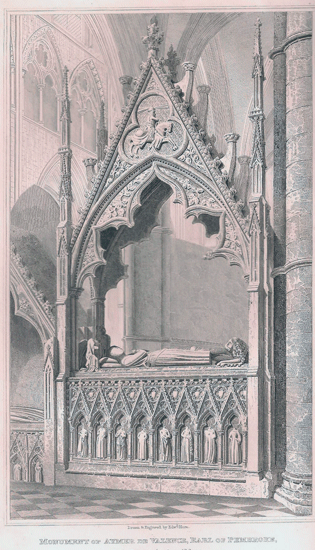 |
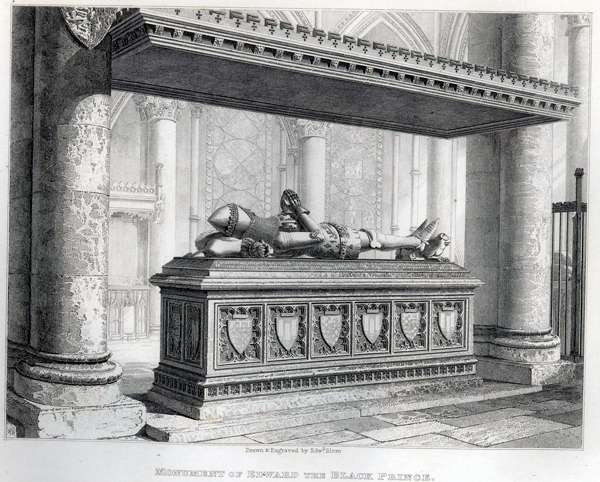 |
| A Gablet |
A Canopy |
A Tester |
|
| Glebe
|
(Latin: soil) The parish priest was
originally dependant only on tithes for his income but also on
his glebe, which was parish land set aside for his use also. Glebe land
throughtout the parishes varied greatly in size, quality, and location.
In some parishes the glebe was large enough for the priest to actually
sub-let part of the land and thus receive additional income. |
| Group Ministry |
Is formed when a group of adjacent parishes form an
informal grouping while each retaining their independance. This
alleviates clergy staffing problems. |
| Incumbent |
(Greek: to obtain possession of) The
holder of a benefice who may be a rector, vicar or,
until 1968) a perpetual curate. See also tithes. |
| Induction |
Following institution of a new incumbent
to a parish, the next stage is inducted by the archdeacon
who conveys to him the church key and asks him to toll the bell. By
these acts the new incumbent now has legal right to the
benefice. |
| Institution |
The admission by the bishop of a new incumbent
to the parish with the accompanying rights and responsibilities.
Institution is normally followed by induction. |
| Minor Orders |
Orders in the Roman Catholic Church below the major
orders of deacon, priest and bishop. Before 1927, these were:
Acolytes, Door-Keepers, Exorcists, and Lectors.
An exorcist's duties included exorcism. The power to
perform exorcism was not confined to exorcists alone.
An acolyte assists the priest, specifically at the altar
A lector is a reader.
A door-keeper has responsibilities similar to those of a verger.
However a verger need not be ordained. |
| Minster |
I should have liked to have written 'pass' in this
column because, as architectural historian Alec Clifton-Taylor says in
one of his excellent 'English Towns' television programmes: 'No one really knows'.
It is often said that it refers to a church which was formerly a
monastery but this cannot be correct as York Minster (a cathedral) was
never a monastic cathedral as was, for example, Canterbury Cathedral. However the word
is derived from the same Latin source (monasterium) as is
monastery.
It is said that it to have been applied to any monastic church
(which does not appear to be true) as well as to any large or important churches; this
latter would then correctly include not only York but Beverley, Southwell
(now a cathedral), and
Wimborne among them. This definition would thus seem to include any
church at all, as Beverley is certainly very big while Wimborne
certainly is not.
It seems like Mr Clifton-Taylor was right!
It is also said to have been applied to a church which in Saxon times, before the
proliferation of parish churches, had a number or priests - that is,
secular canons - who served the surrounding area, which would have been
much larger than a parish and could not have been served by one man
alone. This would seem to be the best answer to this curiosity.
Some places names, e.g. Mister Lovell, are said to have contained a
house of secular canons. More research is needed to confirm this.
The above changes of meaning, if you think about it, is not unique to
minster but to many words change their meaning, widen their
meaning, restrict their meaning, or even reverse it over the years.
To confuse the matter even further, in the 20th and 21st century some
parish churches which are consdered important or significant in some way
have been given the honorific title of minster: one example was
Leeds parish church but there are several others. Bradford has a
cathedral so why not Leeds a minster! This is similar to certain towns
being given the honorific title of city. The will certainly
confuse generations to come!
|
| |
|
| Parish |
|
| Parsonage |
This term refers to the parson's house, similar to
rectory and vicarage. However it also means |
| Patron |
The right
(advowson) to nominate a priest to a benefice is held by the bishop or other person or
body, known as the patron. However this bishop may refuse this
nomination by the patron.
This situation developed thus: with the growth of parishes
(and the decline of the minster system, where a group of
itinerant priests served a large surrounding area)
lords of the manor needed to establish parish churches on their land.
Having occurred expenses by building the church and the accompanying
buildings) and loss of income by donating the glebe, the lord of the
manor wished to have a choice in selecting the cleric who would become
the incumbent. The bishop also expected to have some input into this
choice.
A patron now will consult with parish representatives about the choice
of candidate. |
| Peculiar |
A church, parish or parishes which is exempt from the
rule of the bishop in the diocese in which it is situated. The Temple
Church and Westminster Abbey are examples of peculiars, being exempt
from the jurisdiction of the Bishop of London. There were formerly a
number of peculars such as Wimborne Minster in Dorset and Masham in
Yorkshire. The latter was designated a peculiar because it was said to
be too far away for the Archbishop of York to visit. Hence Theakson's
Brewery in Masham produce an excellent beer called Old Peculiar.
Also spelt peculier. From Latin: peculiaris -
relating to private property.
Note: if visiting Yorkshire - and especially around Masham and the
surrounding area - do not pronounce Masham as Mash_am:it is Mas_am. |
| Pulpitum |
From Latin: platform. This is a massive
stone screen with a central doorway separating the nave from the choir,
usually a single (but occasionally) wall between piers of the crossing.
Its actual position varied but it was always east of the Rood Screen. |
| Province |
A major ecclesiastical administrate unit, comprising a
number of dioceses. In England there are two provinces, namely
Canterbury and York, and the archbishops of Canterbury and York
exercise jurisdiction over their respective provinces. The church in
Wales was disestablished and separated from the jurisdiction of
Canterbury in 1920, becoming the Welsh province of the Anglican
communion. The Archbishop of Wales is appointed by the Welsh bishops and
holds his post in addition to being bishop of his diocese; there is thus
no actual seat of the Archbishop of Wales like Canterbury. The Church of
Scotland is organized on Presbyterian lines but there is also an Episcopal Church of
Scotland which makes up the province of the Anglican Communion of
Scotland. The bishops are elected by the clergy and the bishops then elect a
primus - first among equals - who presides over meetings. The
primus does not have jurisdiction of the province, that is there is no
Archbishop of Scotland. There is also the Church of England in Scotland
but let's not get too complicated! |
| RELIGIOUS ORDERS |
It is unlikely that you will
come across many monuments or references about this subject.
Most of the monuments - but by no means all - are in
Anglican churches and monuments remain from before the
Reformation. Further information may be found on the internet. |
| |
|
| Friar
(Latin Frater : Brother) |
A friar is a member of a mendicant order.
Like monks, friars (v.i.) followed a specific rule including
that of poverty, chastity, and
obedience, but unlike monks, the friars lived in urban areas for
the purpose of preaching evangelization, and ministry,
especially to the poor. Monks owned property not individuslly
but in common - land, buildings etc but, at least initially,
friars depended on survival on the goodwill of those they
preached to. Friars travelled to fulfill their calling but
eventually did built churches to act as a centre for this
purpose. In contrast monks remained cloistered in abbeys and
priories an - in common - became very rich from
bequests, work such as sheep farming: witness the fine churches
they built, most now in ruin, such as Fountains Abbey in
Yorkshire.
There were many orders of friars following variations of the
principal rules and a list of the four main ones follows.
Some of the orders have become extinct but many survive today.
Franciscans (Grey Friars) established 1209 by St Francis of
Assisi.
Carmelites (White Friars) established in 1155 but did not become
mendicant until 1245
Dominicans (Black Friars) established in 1216
Augustinians (Austin Friars) established by St Augustine of
Hippo in 1244
A friar may be ordained priest but not necessarily.
|
| Something About Friars |
I'm sure everyone knows about Friar Tuck, the fat,
jolly friar and companion of Robin Hood, who
lived in the time of King Richard the Lion Heart. There's
some wrong here: the various orders of friars were
established in the 13th century while King Richard was
killed in 1199. Never mind, it's a good story.
There are plenty of places with the name Friars
in them: Black Friars in London, famous for its bridge
and railway station, is just one. Presumably these
places once had a friary there. Billy Bunter's school
was called Grey Friars, where there must have been a
friary at one time. Sorry that's fiction too.
Richard III was originally buried at Grey Friars' Church
Leicester.
And true: Black Friars were aptly named: they were in
charge on the Inquisition!
|
|
| Monk
(Greek Monakhos: Solitary) |
A man who has renounced worldly persuits to
devote his life to spiritual endeavours. Monasticism exists not
only in Christianity but also in Hinduism, Sikism, Jainism, and
Buddism; the latter are probably the most familiar to us;
monasticism does not occur officially or is forbidden in Islam
or Judism. Here we will outline only Christian monasticism.
Monasticism began in the East - that is where Christianity
began, after all - and took basically two forms: hermits, men
who lived by themselves and men who formed communities living
together in abbeys and priories. Their aim was to live as Christ
had done. an impossible task but they attempted to do so. They
followed a rule - a rather a book of rules - the main rules
being poverty, chastity and obedience (to the abbot or prior).
As the monasteries became more wordly, new abbeys were founded
under a different - or more correctly modified - rule.
Monasticism spread to the the west and Benedict of Nusia
introduced his Benedictine rule for his monastry at Monte
Cassino, Italy, a rule that was adapted by many abbeys. The
monks were called Black Monks because of the colour of their
religious habits.
|
| Nun |
|
 |
|
|
|
|
| Effigy of a Nun |
|
|
|
|
|
| |
|
|
| Rood Screen |
In a medieval church, a decorated wooden or stone
screen which separated the chancel from the nave. It supported the rood
loft on which was the Great Rood. Most were pierced by tracery and had a
central gated opening which allowed access to the chancel. Access to the
loft was via a stone stairway set into the adjacent wall. The Great Rood
(Old English: Cross) was a figure of Christ Crucified flanked
by St Mary and St John. The Great Roods were removed at the times of the
Reformation although several Rood Screens and a few Rood Lofts survive.
Occasionally evidence of the stairs to the Rood Loft may be found when
all the structures they served are long gone. In the Gothick Revival
several churches were built with Rood Screens and Lofts. See also:
pulpitum |
| Tithes |
A tithe was a tax - a tenth - on the annual produce
of land or labour levied in a parish to support its priest, maintain its
church, and provide poor relief. Payment was made compulsory as early as
the 10th century. Hence the delineation of parish boundaries. The produce
raised was stored in tithe barns. From the 19th century, tithes - which
were often a cause of bitter dispute - were progressively modified and
restricted by law and in 1925 abolished completely.
If the rector were not the incumbent, then the tithes
were apportioned between the rector - or
appropriated by an institution, such as a monastery or collegiate
church, and a vicar, who was a deputy appointed by the
rector to take care of the parish. This division of tithes was
known as the rectorial tithes - or Great Tithes - a vicarial tithes - of
lesser tithes. The latter were raised from labour and minor produce and,
consequently, the most difficult to collect. Often the income received
by the vicar, were insufficient for his needs and he would have to supplement
his income by growing crops (in addition to the produce of his glebe)
and even keeping pigeons.
See also: vicar, rector, appropriation,
|
| |
|
| |
|
The Church
as a Building
Inside and Out: Architecture, Fixtures & Fittings |
| |
|
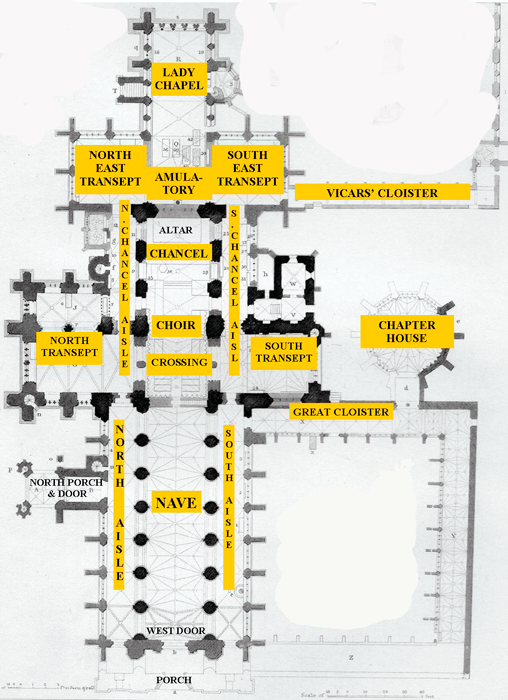 It goes without saying, of course,
that no two churches are the same: they may be very similar,
especially the smallest ones, but it is highly unlikely you will
find two the same. It goes without saying, of course,
that no two churches are the same: they may be very similar,
especially the smallest ones, but it is highly unlikely you will
find two the same.
The reasons too are fairly obvious. Geography, of course,
as churches vary not just from country to country but, to a
lesser degree, in different areas of the same country. History
too as churches will vary as building techniques develop:
compare a simple Anglo-Saxon church to a 'Perpendicular' one.
And of course, the size of the parish: one with few parishioners
will have a church which is little more than a rectangle, with
steps or screen to separate the nave and chancel. If the number
of parishioners grows the simple church will grow - if it is not
replaced completely - by having bits added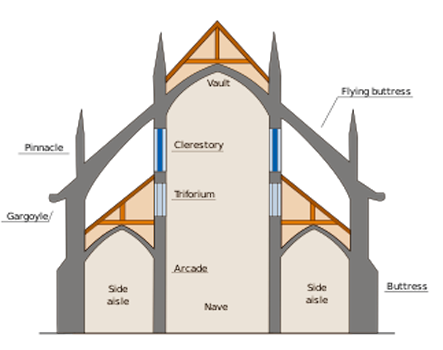 on, such as aisles,
transepts, a lady chapel, vestries and administrate rooms. The
add ons are often of the current styles so the church will show
to us that it was build at different times. on, such as aisles,
transepts, a lady chapel, vestries and administrate rooms. The
add ons are often of the current styles so the church will show
to us that it was build at different times.
The plan here is of Hereford Cathedral which was a monastic cathedral.
Now a Cathedral of the New Foundation. It
was built to be big, being the mother church of the diocese.
While we are here, what does the prefix arch ...
actually mean? Architect - Greek: Arki
+ Tekton - Chief
Builder. Archbishop - Greek: Arki + Episkopos -
Chief Overseer. Archaeology - Greek:
Archaios + Logos - Ancient Science. Arch -
Latin: Arcus - Arch or Arc (geometry)
|
| Aisle (see plan
and cross section) Latin: ala - Wing (of a bird) |
The part of a church on either side of the nave,
divided by a row of pillars. It is not the
gangway running down the centre of the nave, although this sense is
often used.. The transepts may also have aisle(s) and there may be only
one aisle alongside the nave. |
| Ambulatory (see
plan) Latin: Ambulatorius - place for walking |
A walking space around the chancel linking the two
chancel aisles |
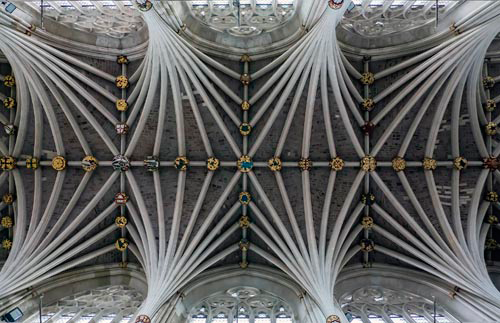 |
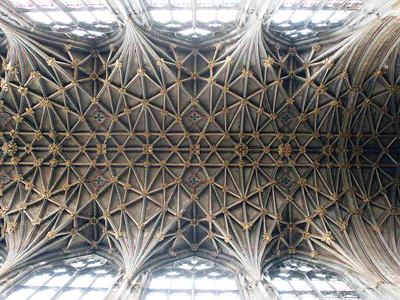 |
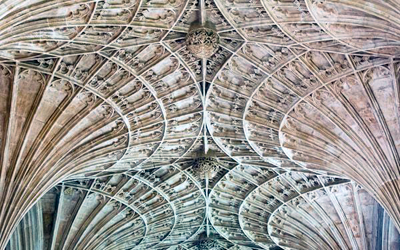 |
|
Tierceron Vault |
Lierne Vault |
Fan Vault
|
| This form has additional ribs springing from a wall shaft or
pier at the corner of each bay to the ridge along the apices of
each vault. These extra ribs are not structurally essential and
as they are given the same thickness as the principal diagonal
ribs the division of the vault into quadrangle bays disappears (Latin:
Tierce - Third) 13th to early 14th centuries |
|
|
|
| |
| |
| Chapel Latin:
capella - small cloak or cape |
The Frankish Kings preserved the cloak of St Martin
of Tours (d. 397) as a battle which was carried before them in battle.
This cloak was kept in a sanctuary under the care of capellani
(chaplains). The word eventually became used for any sanctuary
containing relicts, then any sanctuary or holy place, and then any
building which is used for worship which is not a church. |
Chapter House
(see plan)
Latin: capitulum - chapter of a book etc |
A building attached to a cathedral of monastry in
which meetings of the chapter are held. 'Chapter' is derived from the
custom of monks gsthering together to read a passage from the Bible or
other sacred book. |
Choir (see
plan)
Latin: Chorus - a company of dancers |
The part of the church occupied by those who sing the
service, usually at the east end, often separated from the nave by a
screen. Also quire. In a parish church often called the
chancel. |
| Clerestory (see
cross section) |
The upper part of the nave, choir and transepts of a
large church, lying above the triforium, if there is one, or above the
arches of the nave, if there is not. It contains a series of windows
above the roofs of the aisles, giving light to the central part of the
building. |
| |
|
| |
|
Crossing (see
plan and cross section))
Latin: Crux - Cross |
The part of a cruciform church where the
where the transepts cross the nave. If the church has
a central tower it is usually above the crossing |
| |
|
| |
|
| |
|
| |
|
| |
|
Nave (see plan
and cross section)
Latin: Navis - Ship |
The body of a church, excluding chancel, choir, and
aisles, which is assigned to the laity |
| |
|
| |
|
| |
|
|
|
| Screen |
A partition of wood, stone, or more rarely
metal,dividing one part of a church from another. Especially nave from
choir. |
| |
|
| Spire |
A tapering structure of stone, wood or other material
of a conical or pyramidal shape rising above a church tower. |
| |
|
| Steeple |
A tower plus spire above |
| |
|
| Tower |
A tall, usually square structure rising above and
part of a church. Many churches have one or more towers at the west end
and large churches a tower above the crossing. Exeter cathedral has two
towers, one above the end of each transept. |
| |
|
| Transept
(see plan) |
The 'short' arms of a cruciform
church set at right angles to the nave and choir, usually set
north-south |
| |
|
| Triforium |
A narrow, interior gallery of some churches opening
into the nave from above the side aisles; the outer walls may or may not
be glazed. The triforium may occur at the level of the clerestory
windows or at a separate level below. From Latin: Tres fortis:
three doors, being originally a building with three entrances.
The triforium has no liturgical purpose ; it was used during the
construction of the church by the builders as a convenient passage way
during construction |
.png)


 It goes without saying, of course,
that no two churches are the same: they may be very similar,
especially the smallest ones, but it is highly unlikely you will
find two the same.
It goes without saying, of course,
that no two churches are the same: they may be very similar,
especially the smallest ones, but it is highly unlikely you will
find two the same. on, such as aisles,
transepts, a lady chapel, vestries and administrate rooms. The
add ons are often of the current styles so the church will show
to us that it was build at different times.
on, such as aisles,
transepts, a lady chapel, vestries and administrate rooms. The
add ons are often of the current styles so the church will show
to us that it was build at different times.